Thai curries are famous for the sublime aromatic flavours balancing sweet, tart, savoury and spiciness. Thai Yellow Curry is one such magnificent example, with its rich yellow colour and a heady combination of herbs and spices in this made from scratch Yellow Curry Paste.
And… welcome to Thai week!!

Welcome to Thai Week!
Every now and then, I like to do a recipe theme week. This week it’s THAI week, with three classic recipes to make your very own Thai feast at home:
Thai Yellow Curry (today’s recipe) – Made from scratch, this is flavour you literally cannot buy in a jar!
Green Papaya Salad
(coming Wednesday)– Great as side, yet substantial enough as a starter.Thai Black Sticky Rice Pudding for dessert! It’s hard to believe you can make something so delicious that is fundamentally, made with just rice, water and sugar…

Thai Yellow Curry
There are many things to love about Thai food, but for me, the jewel in the crown are the curries. I adore that elusive combination of fresh aromatic herbs and spices with the complexity you get from using umami loaded seasonings such as fish sauce and shrimp paste. The colours, meanwhile, make up a rainbow of deliciousness! Striking Thai Red Curry, vibrant Green Curry, caramel coloured Massaman Curry.
And now, the latest addition to my Thai recipe collection – this beautiful splash of sunshine in the form of Thai Yellow Curry!

A bit about this Thai Yellow Curry
What is Thai Yellow Curry?
There are a few varieties of what’s considered “yellow curry” in Thai cuisine. They vary in spiciness and sauce richness, with some made with and others made without coconut cream. The one thing they all have in common is that the sauce is made with a good amount of fresh turmeric which gives the Yellow Curry that beautiful warm golden colour.
The Yellow Curry I’m sharing today is the type that is most common outside of Thailand which has a fairly rich sauce made with coconut cream. The spice level varies from mild (2 fresh chillies) to quite spicy (4 chillies).
What Thai Yellow Curry tastes like
The sauce is savoury, sweet and fragrant with Thai aromatics including lemongrass, turmeric, garlic, eschalots and chilli. It can be as mild as you want or quite spicy – I enjoy it both ways.
It’s not as tangy as other Thai curries, with the obligatory squirt of fresh lime juice you see in other Thai curries noticeably absent in this one.
It’s got layers upon layers of flavours which means yes, there are quite a few ingredients – and it’s worth it! Unlike other Thai curries, I really don’t think any store bought curry paste comes anywhere near made from scratch (sorry guys!).


What you need to make Thai Yellow Curry Paste
There are quite a few ingredients involved in making a yellow curry from scratch if you want a truly authentic result. I urge you to try making this at least once – the taste is incomparable to canned pastes! And in fact, I really can’t recommend any store bought yellow curry paste.
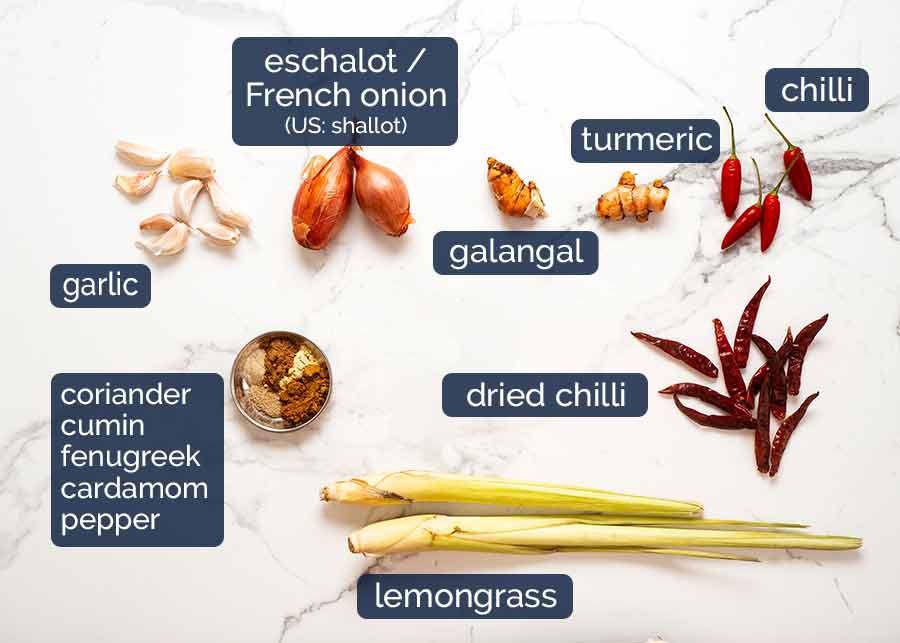
The preparation of the less common ingredients listed below, such as dried red chillies and galangal, are demonstrated in the recipe video below.
Dried red chillis
Dried red chillis have a rounded flavour compared to fresh chillies and have a mellower heat. That said, it’s a good idea to taste the chillies to gauge the spiceiness and adjust accordingly. (Best to nibble once soaked)
If you don’t have dried chilli you can use more fresh chillis instead.
Here is how we prepare the dried chillis:

The dried chillis come whole with seeds inside them.
Roughly chop – this makes it easier to rehydrate, blitz into a paste, and also this loosens the seeds which are spicy. Pick up the chillis only, leaving behind the seeds, and put them in a bowl.
Cover with boiling water and leave for 30 minutes to rehydrate.
Strain chillis and reserve the soaking liquid – we are going to use some of it for the curry paste.
Fresh birds eye chillis or Thai chillis
These bring a bright and fresh taste of chilli by contrast, as well as the real kick!
1 or 2 chillies will give this curry a mild to medium level heat. Use 4 chillis for fairly spicy but not blow-your-head-off. If you’re concerned, you can leave them out!
Here is how I deseed and chop fresh chillies. Yes, I know I should use gloves. I forget! (Usually followed by an eye rub with chilli fingers, copious amounts of swearing, and vowing never to make the mistake again. Repeat.)

TIP: A measuring teaspoon makes a good tool for scraping out the seeds (these are the spiciest part of chillies). Sharper edges than eating teaspoons, and the shape is perfect for seed scooping.
Lemongrass
Fragrant, with a gentle citrus taste, lemongrass is a quintessential South-East Asian flavour. To prepare, cut and discard the top reedy part off – we only want the bottom 10 – 12cm / 4 – 5″. Peel the reedy green shell to reveal the softer white part on the bottom half of the lemongrass.
Substitute: 2 tablespoons of lemongrass paste.

Galangal
This is a plant root used in South-East Asian cooking that looks similar to ginger. It also tastes like ginger but is more citrusy and a little pine-y. It’s actually pretty hard to cut so take care when slicing it! Peel it like ginger, either with a sharp edge teaspoon or (carefully!) with a small knife.
This needs to be finely grated because it’s so hard, it doesn’t blend into a smooth paste, you end up with little gritty bits. I use my microplane, one of my favourite kitchen tools – more information here.

Find galangal at Asian stores, and in some large grocery stores in Australia (Harris Farm and some Woolworths sell it).
Substitute: Use the same amount of ginger + the zest of 1 lime (or lemon).
Fresh turmeric
Turmeric is what gives this curry its essential golden colour, and there’s no yellow curry without it! Fresh turmeric is a root that looks a bit like ginger on the outside but is bright orange on the inside.
The flavour is mild, earthy and slightly bitter eaten by itself. Its primary use in cooking is for healthfulness and for colour.
Prepare it like ginger – peel the skin (scrape using teaspoon or cut off with a small knife), then grate.
Turmeric stains fiercely once grated! Use gloves when handling it, and grate it onto a ceramic or metal plate or bowl. (And yes, the observant among you will notice that yet again, I failed on the gloves front until I started grating it!).
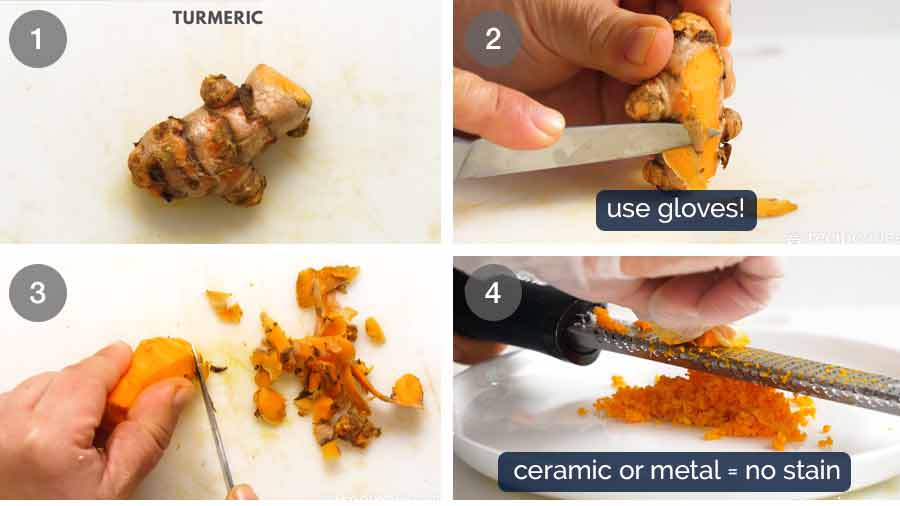
Substitute: 1.5 tsp dried turmeric powder, but it won’t be quite the same so I really urge you to use fresh if you can!
Shrimp paste in bean oil
I use Por Kwan Shrimp Paste in Bean Oil, the most popular Thai shrimp paste sold at Asian grocery stores here in Australia. While many traditional recipes use ordinary shrimp (belacan, in blocks, looks like this) which is made with just fermented shrimp, Shrimp Paste sold in jars where other flavouring have been added (mainly oil, a bit of garlic, and soy sauce powder) goes a long way to making a truly restaurant quality curry paste.
This is especially so when using a blender instead of mortar and pestle as when dried chillies are ground by hand the traditional, the natural oils are extracted. So using a shrimp paste in oil makes up for this.
Por Kwan is the brand I use, pictured below, which is sold at Asian stores.

Best alternatives to Thai Shrimp Paste with Bean Oil:
Belacan dried shrimp paste which is even sold at Woolworths and Coles in Australia these days. The result is very close to using Thai Shrimp Paste with Bean Oil!
Other Thai Shrimp Pastes in Oil – Only Thai shrimp pastes. We tried some other shrimp paste brands sold at Woolworths (made in Vietnam and Cambodia) and while still tasty, they brought a different flavour to the dish.
If you don’t have access to Thai shrimp paste or belacan, I’m afraid I’d suggest giving this recipe a miss because I can’t guarantee the outcome will be successful!
Other ingredients
Garlic – Yes, 8 cloves! It sounds like a lot but the paste will be fried off and the curry simmered for a good 15 – 20 minutes. The garlic will not at all be obvious in the final dish but mellows to become just another instrument playing in this flavour orchestra.
Spices – Coriander, curmin, cardamom, fenugreek powder and white pepper. Our spice selection for this yellow curry which reflects the Indian influence on Yellow Curry. Massaman Curry is another such example of a Thai Curry with Subcontinental influences.
We go a little heavier on the spices for yellow curry compared to red or green curries, which are driven more by their heavy chilli content than spices. Of these spices, fenugreek might be the hardest to find. If you do not have it, leave it out.
How to make Thai Yellow Curry Paste
Once you’ve prepared the ingredients, it’s as simple as blitzing!
TIP: Use a stick blender. Much more effective than blenders, Nutribullets and mini food processors which you need to scrape down repeatedly to blitz thoroughly. Not to mention easier to clean!

After we’ve made the curry paste, we cook it on the stove for a few minutes on a medium heat. The purpose of this step is to dry out the wet paste, toasting the herbs and spices to intensify the flavour.
Yellow curry paste done – now it’s onto the curry. You’ll be glad to hear it’s a simple plonk-and-simmer job!
What goes in Thai Yellow Curry
For this curry, I chose prawns (shrimp) because seafood is a popular choice in yellow curries. Chicken and fish are also other favourites for yellow curry which you can use instead. I’ve included directions for both these in the recipe notes.

Prawns (shrimp) – I like to use medium prawns as small prawns quick so quickly they don’t have time to absorb some of the sauce flavour, and large ones are more difficult to serve / eat.
Use fresh if you can, and keep the tail on. Otherwise frozen thawed is perfectly fine. I don’t need to tell you that the better the quality of the prawn, the better the dish!
Alternatives: Fish and chicken are popular alternatives to prawns, so I’ve included directions for both of these in the recipe notes.
Potato – It’s important to ensure you do not cut the potato too thick, or it will take a long time to cook as potatoes take a surprisingly long time to cook in coconut sauce! The cutting size is specified in the recipe.
Any kind of potato is OK (waxy or starchy) for this recipe, but waxy will tend to hold its shape better.
Carrot – Ditto the carrots on the thickness caveat! Follow the recipe!
Coconut cream – We use cream to give the curry sauce its thickness as well as richness. You can use milk or lite versions, but the curry will be a little thinner in consistency and less full in richness. Look for brands that have a high percentage of coconut extract. Ayam brand is my choice.
Tamarind puree – Tamarind is a sour fruit pod whose pulp is used in South East Asian food to add acidity to food like this curry. You can buy it is a jarred puree in large Australian supermarkets (Coles, Woolworths) or Asian grocers.
Bamboo shoots – Sold in cans at large grocery stores (Woolies, Coles, Harris), they have a crisp juicy texture and have a unique taste. Substitute with green beans (for similar shape) or more carrots.
How to make Thai Yellow Curry
This part of the recipe really is simple – just simmer everything in a skillet.
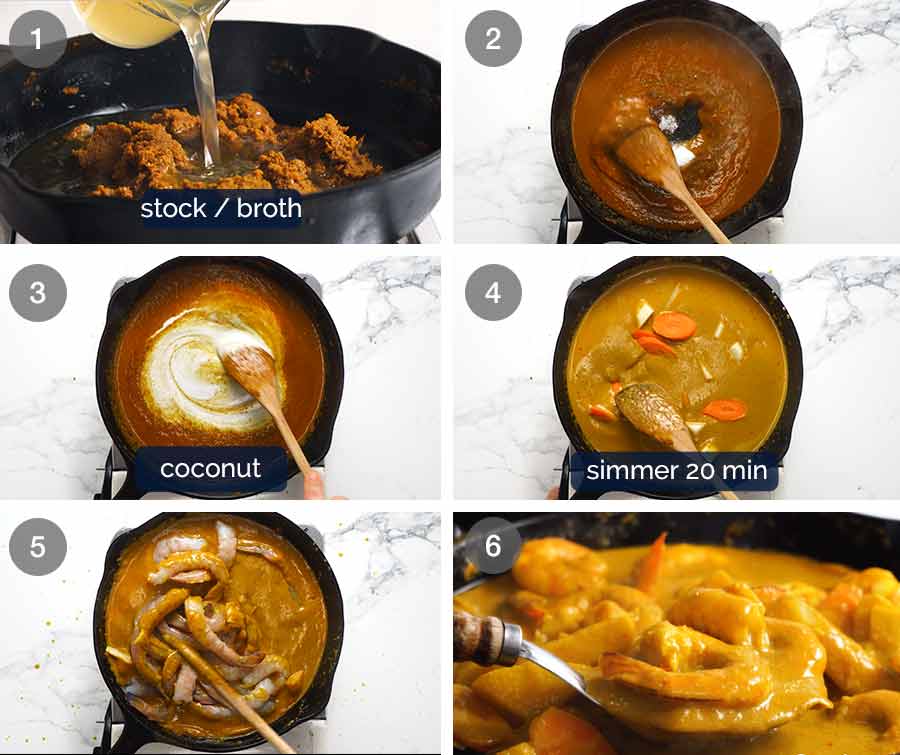
Add chicken stock into the cooked off curry paste and stir to dissolve.
Simmer chicken stock – Simmer on medium heat for a minute to bring the flavours together.
Add remaining curry sauce ingredients: Reduce heat to medium low. Add tamarind, fish sauce and sugar. Stir until tamarind is dissolved.
Simmer 20 minutes – Add carrot and potato, then simmer the sauce for 15 minutes or until the potato is nearly cooked (pierce with a knife to check), it might take up to 20 minutes. Potato takes a surprisingly long time to cook in a thick coconut curry sauce!
If your heat is too strong and the sauce reduces and thickens too quickly, lower heat and add a splash of water.
Prawns and bamboo shoots: Add prawns and bamboo shoots. Stir, then cook for 3 minutes until prawns are just cooked.
Plate up! Once the prawns are cooked, remove the curry out of the hot skillet into a serving bowl to prevent the prawns from overcooking. Overcooked, rubbery prawns in a homemade yellow curry from scratch is a depressing thought!
Next, we’re going to finish the dish with a few garnishes!

Garnishes for Thai Yellow Curry
Here are the garnishes typically used to serve Thai Yellow Curry.
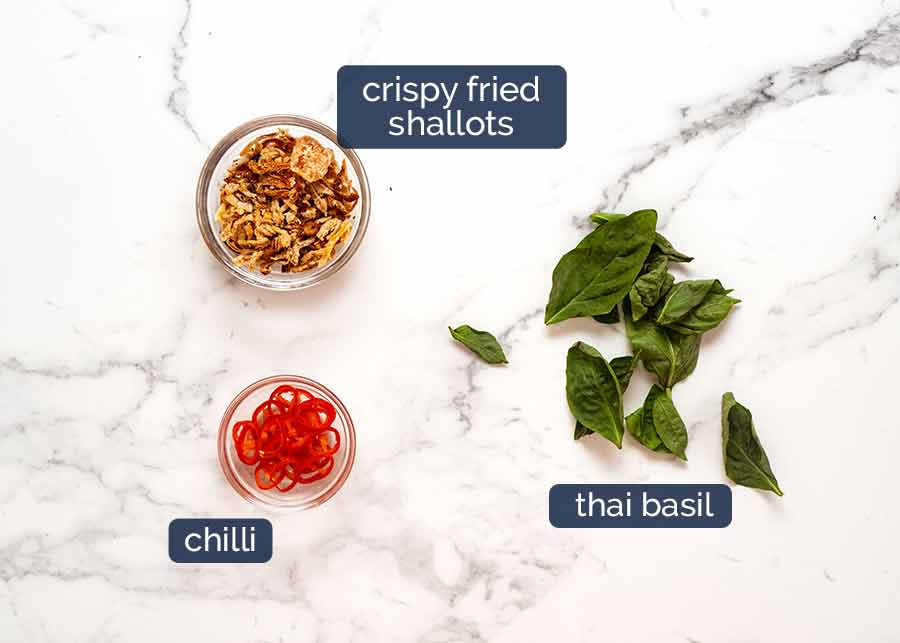
Thai Basil Leaves – Tastes like regular basil plus a bit of aniseed flavour. Highly recommended to finish this dish off.
Substitute with coriander/ cilantro (best) or normal Italian basil.
Crispy fried shallot pieces (optional)– Salty little fried bits of shallots brings a great finishing touch to the dish both for the flavour and texture. Find it in the Asian section of supermarket but cheaper at Asian stores.
Fresh chilli slices – Purely option, for a splash of colour and extra spice, if desired. Use large chillies if you want the colour without the spiciness.
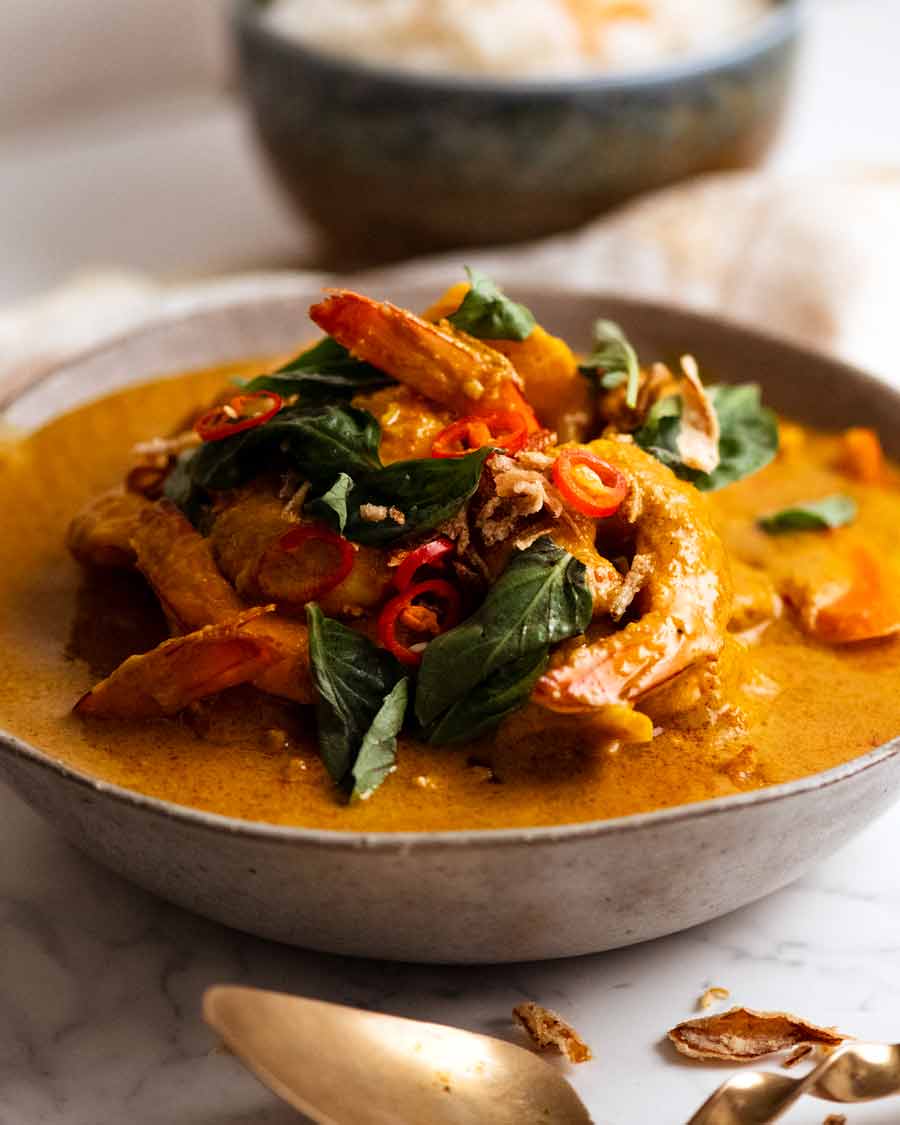

Phew! And with that, I am done – you are now armed with everything you need to know to make this Thai Yellow Curry!
A quick and easy recipe, this ain’t!
This is certainly not a quick ‘n easy midweek meal. There’s a fair few ingredients, and to make it as written calls for a trip to the Asian grocery store. It involves sourcing ingredients that may be new to you, and preparing ingredients you haven’t cooked with before.
But is it worth it?
Hundred times over, YES YES YES!
While these days, you can get very good store bought curry paste for Thai Red Curry, Green Curry and Massaman Curry, I am yet to find an acceptable store bought Yellow Curry Paste, even at Asian grocery stores.
And, at the risk of sounding totally obnoxious, this recipe delivers a curry that’s far superior to most standard suburban Thai takeout places that take the jarred curry paste shortcuts.
So if you’re a Thai Curry fan, I urge you to try making this at least once. The taste is incomparable to canned pastes! – Nagi x
Watch how to make it
Hungry for more? Subscribe to my newsletter and follow along on Facebook, Pinterest and Instagram for all of the latest updates.
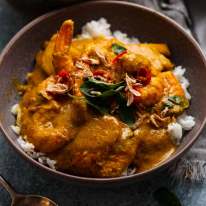
Thai Yellow Curry (from scratch!)
Ingredients
Thai Yellow Curry Paste:
- 10 dried red chillis (~6cm/2.5" long), chopped into 1cm / 0.5" pieces (Note 1)
- 1 – 4 fresh birds eye chillis , deseeded, roughly (1 for extremely mild, 4 for fairly spicy, Note 2)
- 2 lemongrass stems (Note 3)
- 1 large or 2 small eschalots , roughly chopped (~ 1/2 cup) (Note 4)
- 2 tbsp fresh turmeric , finely grated (about 2cm / 0.8" piece) (Note 5)
- 2 tbsp galangal , finely grated (about 2cm / 0.8" piece) (Note 6)
- 8 cloves garlic , roughly chopped
- 1 1/2 tbsp Thai shrimp paste in bean oil (Note 7)
- 1 tsp ground coriander
- 1 tsp ground cumin
- 1/4 tsp ground cardamom
- 1/2 tsp fenugreek powder (Note 8)
- 1/8 tsp white pepper (sub black)
Curry:
- 3 tbsp vegetable oil (or canola or peanut oil)
- 1 medium potato , peeled, cut into 2.5cm / 1″ pieces x 1cm/ 0.4″ thick (Note 9)
- 1 small carrot , peeled, sliced into 5mm / 0.2″ slices on the diagonal
- 1 cup chicken stock , low sodium
- 300 ml / 10oz coconut cream (Note 10)
- 4 tsp fish sauce , plus more to taste (Note 11)
- 5 tsp white sugar
- 2 tsp tamarind puree (Note 12)
- 350g / 12oz prawns/shrimp , medium, peeled, tail on optional (700g/1.4lb unpeeled) (Note 13)
- 1/2 cup bamboo shoots , canned, drained, loosely packed (Note 14)
Garnishes & serving:
- 16 Thai basil leaves (highly recommended, Note 15)
- 1 Red chilli , finely sliced (optional, use large for not spicy)
- 2 tbsp Crispy fried shallots (optional, store bought, Note 16)
- Jasmine rice
Instructions
Curry Paste:
- Soak dried chillis: Roughly chop chillies and transfer to bowl, leaving behind seeds. Cover with boiling water and soak for 30 minutes then drain (reserve soaking water).
- Check spiciness: Have a nibble of soaked chilli, should not be that spicy. If it is spicy, only use 1/3 to 1/2 of the amount (Note 1).
- Prepare lemongrass: Remove woody top half and outer layers of lemongrass. Grate with microplane. (See in post or video for preparation demo)
- Make curry paste: Place chillis, lemongrass and all remaining curry paste ingredients in a jar just wide enough to fit a stick blender. Add 3 tablespoons chilli soaking water. Blitz with stick blender until smooth so there's no hard grit – rub between your fingers to check – about 15 seconds on high. (Or use small food processor or Nutribullet, scraping down sides well).
Curry:
- Cook off curry paste: Heat oil in a medium heavy based skillet over medium heat. (Mine is a 26cm / 10.5" Lodget cast iron) Add curry paste and cook for 3 to 4 minutes until it dries out a bit a smells fragrant.
- Reduce stock: Add chicken stock, stir to dissolve paste, then simmer for 1 minute.
- Add remaining curry sauce ingredients: Reduce heat to medium low. Add tamarind, fish sauce and sugar. Stir until tamarind is dissolved. Then stir in coconut, carrot and potato.
- Simmer: Bring to simmer, then simmer gently for 15 minutes or until potato is almost fully soft. Pierce with knife to check, it might take 20 minutes.
- Prawns and bamboo shoots: Add prawns and bamboo shoots. Stir, then cook for 3 minutes until prawns are just cooked.
- ADJUST sauce: Taste and adjust the curry sauce at this point. Thin sauce with stock or water, add salt, fish sauce or sugar if needed. See Note 17.
- Serve! Transfer curry to serving bowl. Garnish with Thai Basil, fresh chilli and crispy shallots. Serve with jasmine rice.
Recipe Notes:
- Prawns – can use frozen, just thaw and drain off excess water well.
- Fish – Firm white fish fillets cut into 4cm / 1.3″ pieces. Cook as per prawns.
- Chicken – use 300g / 10oz chicken thighs (boneless, skinless), add with potato
- Thin sauce with water or stock
- Thicken with extra coconut cream.
- Salt and umami: fish sauce (1 tsp at time), plain salt if if the fish sauce taste is strong enough but it still needs some saltiness
- Sweetness: sugar
- More spice: use fresh chillies for garnish. Don’t add sriracha or chilli sauce into the curry sauce.
I adore Thai curries!
Proof:
Life of Dozer
Dozer! You were NOT supposed to go in the water today! 👿

And then of course, he did THIS (5 minutes before I was due home for a zoom meeting 🙄):







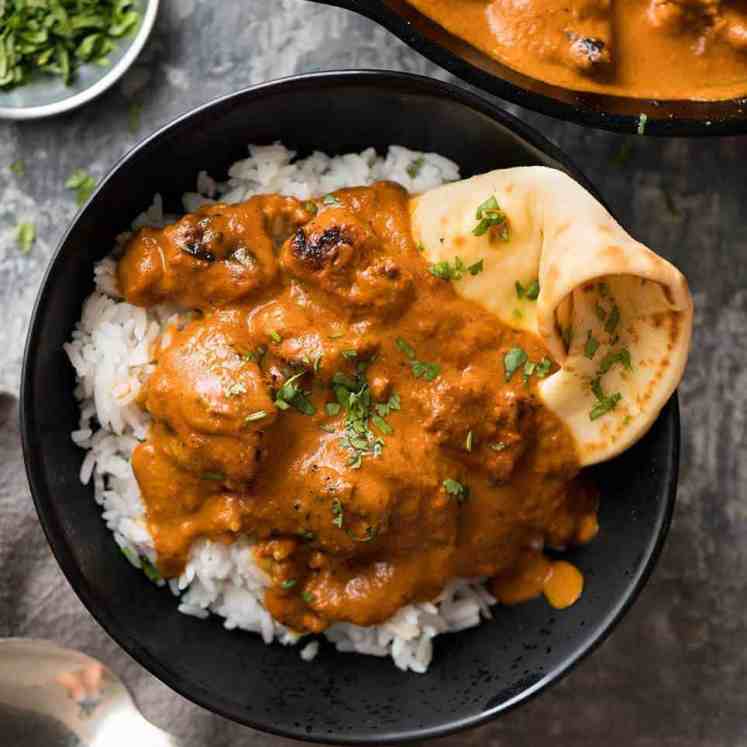
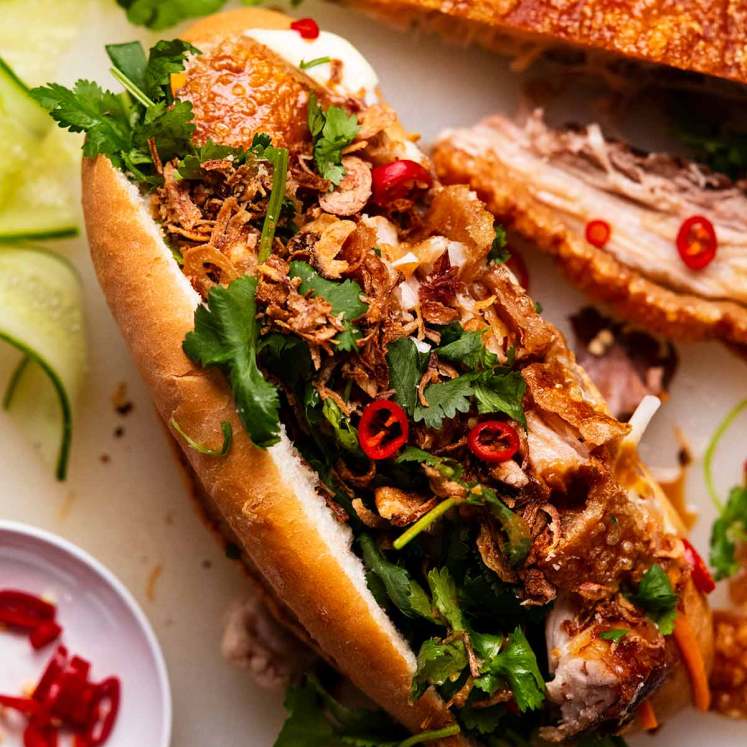

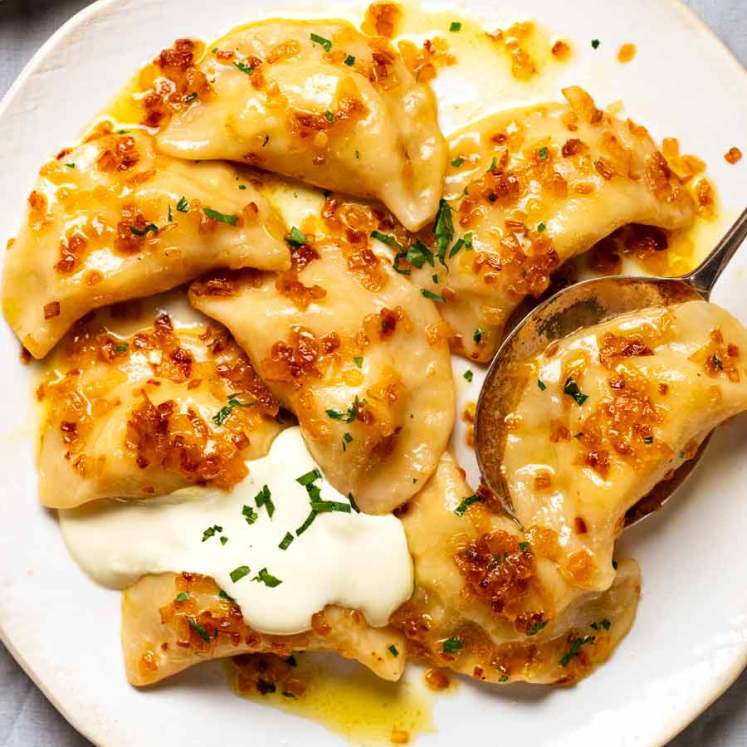
Hey Nagi. I absolutely love the flavour and authenticity of your recipes, so thank you. I have what is probably a dumb question re your Thai yellow curry recipe. I made the curry paste as directed (ok, well, maybe I threw in a few more cloves of garlic, but still 🙂 pretty close) and I have more than a cup-and-a-half. That’s more than the coconut cream! Am I meant to use ALL of the curry paste? Won’t that overpower everything else? Even when I just taste it, it makes my tongue go numb and tingly!
Hi David – you shouldn’t have a cup and a half of paste – the volume of the ingredients doesn’t add up to that (even with the extra garlic!)! I would think it’s between 1/2 cup and 3/4 depending on the size of your eschalots. Did you make sure you measured the ingredients properly? N x
I’m dying to try this, but can’t eat onion (including eschalots) due to fructose intolerance. Can I just leave it out, or do I need to substitute something else to replace it?
Hi Nagi,
Could you use crab with tthis recipe?
Hi Nagi,
Could you use crab with this recipe?
I made this curry from scratch and it was absolutely amazing! It is certainly worth making this paste from scratch. I cannot wait to make it again
Hi Nagi, I’m wanting to make this delicious dish for my birthday dinner with the family tonight. I have a vegetarian guest so l was wondering if l could use chickpeas and sweet potato instead of meat or fish. Should l use the hover function as l have 10 people coming. Thankyou Nadene
Hi Nagi, Just wondering if the recipe for curry paste is for one dish of curry. Or is that enough paste for future dishes? Just looking at the 8 cloves garlic:)
Yep! That’s for the one recipe’s worth of paste! 😀 N x
Ok well this is just unbelievably good!!! I actually can’t get over how good it is. Thank so much Nagi, you rock!! xx
I just cooked your Thai Yellow curry, using chicken instead of prawns. I gotta say it was so good & so authentic, I can’t believe it. Also it was quite easy to make as well, I’m using prawns next time & then I’ll try fish too. Thanks so much Nagi. ❤️ .
Hi Nagi, is this recipe freezer friendly?
Yes 100% Tara! N x
Dear Nagi,
You are wonderful, and your recipes are amazing. Always delicious! I’m sorry you had to face the unjustified vitriol of one of my mean and ignorant compatriots. There seem to be more and more of them!
For the record, I have not eaten ground beef in years, and there are millions like me here. It’s bad for the planet and bad for health, and frankly unimaginative as a culinary staple.
It is precisely because of your imagination that I found your blog, and I read it every single day, excited to find what exotic corner of the world your palate will take us to, or what secret technique you will impart that improves a favorite dish.
Your philanthropic venture is impressive and deeply touching, at a time when more people around the world are becoming selfish and cruel. Keep doing exactly what you’re doing, and if you get mean mail from the ignorant, remember what Jean Genet said: “Dogs bark, but the caravan rolls on.”
Your devoted fan,
I love so many of your recipes Nagi. This one was good but it was super spicy (and I like spice). I used just one of the Thai bird chilies but I think the issue was the ten dried chilies. I made sure to get all the seeds out but it was still so, so spicy. Maybe we have different chilies in the US? Also, I couldn’t find the soy bean shrimp paste anywhere. We have a lot of Asian stores here in the Seattle area and I hit two of the big ones and couldn’t find it. Ended up getting a Chinese shrimp paste that I only used about half as much because I didn’t want to turn it fishy. I really liked the flavors overall and may try it again dialing back the peppers.
An absolutely superb meal. Thank you Nagi once again.
OH MY GOD! I absolutely love all your recipes but this one is my favourite! Better than any yellow curry I’ve eaten at a restaurant. Family gave me a 10/10! Nagi you are amazing!
Hi Nagi,
I made this Yellow Curry last weekend and it was PHENOMENAL! I used chicken thighs, as that is what I had at hand. I will make it again, next time using prawns.
Thanks for yet another brilliant recipe.
Ren x
Another amazing recipe, doubled the paste recipe so I could freeze half. Thanks Nagi
Hi Nagi,
Making this tonight and I can’t wait, neither can my husband ! only thing i have missing is the bamboo shoots, oh well. It will be great I’m sure regardless as are all your recipes. good on you for Recipe Tin Meals, good Karma on you .
When are you going to have your own TV show ??? seriously
I really liked this recipe but as a comparison made another batch with maesri brand yellow paste. This one was more rounded & earthier (think due to fresh turmeric) but lacked the spiciness of the maesri – hence next time I would also add ginger. Details are long winded (can give if you want & measurements but….) I only needed half the amount of dried chillis (mine are fairly hot) & yellow curry is not meant to be too hot I think.. I used 2 fresh chillis. I made the 2 curries identically except for adjusting fish sauce, palm sugar & tamarind.
The maesri brand was more orange in colour & this one more yellow. I also used chicken with skin on as a like to end up with the oil separation.
I really liked both & if it wasnt for this recipe, would not have thought to tweak the bought paste with tamarind & shrimp paste (only the usual sugar & fish sauce).
Nice to have the earthiness of paste made from scratch but a quick curry, the alternative was just as good – just a little different.
Outstanding! So much flavor. Once again Nagi you have produced a great recipe. Our times for mis en plus and cooking are different from yours but who cares with such great results!
Thanks so much. We loved this recipe.